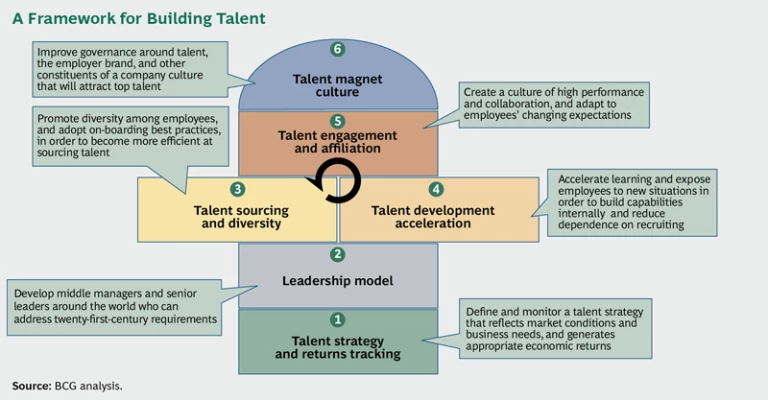This article from The Boston Consulting Group’s Organization practice is the first in a series on talent challenges. Future articles will examine the implications for talent management of several trends:
- The shift in growth opportunities and competitive threats in high-growth markets, where culture, work habits, and demographics may differ substantially from a company’s familiar markets
- National economies that are slowing and might be sliding into another recession
- The ever-faster pace of technological change and innovation, which puts greater demands on employee learning and retraining
- The unprecedented number of generations working side by side in an organization
Build your bench of talent soon, or fall behind competitors that are far better prepared. This imperative now confronts organizations in virtually every industry and location, in mature markets and emerging economies alike. Because executing one’s business strategy hinges on having the right talent in the right places at the right time, the talent issue touches the entire organization, not just the HR function. All executives are therefore responsible for making their companies talent magnets.
Talent is variously defined as the narrow slice of staff with senior-leadership potential, as the employees who fill critical jobs, or as an even broader set of highly skilled people in certain functions. We focus here on managing in a specific way the people who bring competitive advantage to a company.
Where’s the greatest vulnerability? Talent is already in short supply for many positions. For example, in a worldwide survey conducted by BCG in 2010, 56 percent of responding companies cited a critical talent gap for their senior managers’ successors, in part because their internal talent pools are too shallow.
In mature nations, despite slow economic growth and continued high unemployment, most companies are hard-pressed to find high-performing, high-potential individuals to serve as tomorrow’s middle managers and senior leaders. Roughly 75 million baby boomers are nearing retirement in the U.S., for example, with only 30 million Generation Xers set to replace them. Mature economies are also contending with talent shortages in functions such as engineering and IT. And multinational companies based in mature nations will face intense competition for talent as they expand abroad.
In high-growth markets, the challenge often lies in finding sufficient numbers of skilled workers. It’s a question of quantity, as growth in the number of university graduates in some regions lags GDP growth by a factor of two or three. It’s also a question of quality, with only 25 percent of Indian and 20 percent of Russian professionals considered employable by multinational companies, according to a BCG analysis.
The shortage of skilled people will worsen over the next decade, making it more difficult for organizations to penetrate new markets and compete effectively in volatile ones. Where industry leaders could once remain dominant in market share and profitability for decades, companies now face fierce battles to maintain their lead for just a couple of years. Volatile markets often demand new business models and new types of talent to make a company’s business strategy successful.
The Merits of Building Talent
The new reality is that companies face a seller’s labor market, with talented individuals having more job choices than ever before. Some companies frame their response to the shortage in terms of a “war for talent.” An unintended consequence of this orientation is that companies in industries (such as investment banking) or regions (such as eastern China) where there is intense competition for people tend to bid up the price of talent—often far ahead of an individual’s capabilities. As the shortage worsens, companies desperate to fill gaps quickly default to their standard recruiting sources, perpetuating a corrosive dynamic of external candidates overpromising and then job-hopping to follow the money, ultimately destroying company value.
But there is another option that is more sustainable: building talent internally. This “make talent, not war” strategy confers an advantage on companies that need to change their mix of talent in response to a new business model or growth strategy or that need to adapt to shifts in their markets.
We’re not suggesting that companies eliminate external recruiting. In fact, an internal/external sourcing ratio of between 60/40 and 70/30 is most effective in both attracting and retaining people who value career development opportunities. Attracting different talent profiles, and the cognitive diversity that results, improves a company’s problem-solving and innovating abilities. But building strong talent internally reduces the need to expand expensive and time-consuming recruiting processes and reinforces the company’s value proposition to employees and potential recruits.
Consider data from a recent BCG survey of executives. High-performing companies, as defined by revenue growth and profitability over three years, fill 60 percent of their top manager positions internally, compared with a mere 13 percent for low-performing companies. High performers realize the need to have a holistic talent strategy in place to leverage this most valuable of assets.
Most companies, though, lack a comprehensive talent strategy and devote insufficient time to talent management. In a 2010 BCG survey of executives, more than half the respondents said they lack a dedicated talent-management unit. Respondents also said that their CEO and other senior executives spend less than nine days a year on activities related to talent management, far less than the 20 days per year we observed among best-practice companies.
Foundations for Building Talent
Rather than relying on serendipity, companies with an effective approach to talent management take an end-to-end view of talent. This approach is grounded in business strategy, treats human capital with the same rigor as a capital asset investment, and looks for opportunities throughout the tenure of the employee. We consider six building blocks to be critical to an effective talent program, as shown in the exhibit below.
Talent Strategy and Returns Tracking. The foundation of a solid talent strategy must be the company’s business strategy and growth objectives. By asking where the company is now and where it wants to be in the future, executives can identify current gaps in talent, both quantitative and qualitative, and map a path forward based on the business plan and resulting talent requirements. It takes years to assemble a generation of strong leaders, so one needs to plant the seeds early and in the right places. Just as investments in assets and their returns are tracked and measured, so too should investments in people be tracked. Tracking metrics, such as the size and quality of the talent pipeline, the speed with which functional talent gaps are filled, and the level of employee engagement, will help ensure that the company hits its performance goals. Rigorous performance metrics will also help guard against inflated claims regarding an employee’s capabilities.
Leadership Models. Leadership models need to be grounded in the broader business context. Today’s volatile competitive environment calls for adaptive leaders who embrace uncertainty and experimentation and manage internal and external stakeholders through influence and empathy more than through command and control. Equally important are middle managers, who understand the vision that drives those at the top of the organization and the pain of those at the bottom. Because they supervise the majority of employees, middle managers have a strong influence on overall employee engagement and development, and therefore on company performance.
Talent Sourcing and Diversity. Today’s competitive markets are characterized by globalization and by increasingly distinct and demanding customer segments. Companies staffed exclusively with similar-looking, like-minded employees lack the broad range of insight and experience needed to meet the challenges of a globalizing world. By contrast, organizations that tap into the full spectrum of capabilities offered by a diverse workforce are better equipped for a dynamic environment. As companies diversify the employee base, they will also need to modify their employer value propositions to meet more varied expectations. Members of the Millennial Generation, for instance, tend to value mobility and continual performance feedback, and they respond to different incentives than older generations.
Talent Development Acceleration. Today’s young talent demands a steady stream of developmental opportunities. A career “trellis” offering multiple options, as distinct from a career ladder oriented only vertically, can help address that need. To accelerate the development of experience and competencies, companies can immerse employees in unfamiliar markets, temporarily assign them to external groups, or appoint them to joint ventures. These initiatives help raise engagement levels, reduce unwanted attrition at all ages and levels, and ensure a continual flow of talent.
The ability to accelerate development and retrain on demand provides companies with the flexibility needed to quickly address talent gaps and surpluses. Companies hoping to capitalize on China’s growth, for instance, may find that they need to build a generation of leaders in just five to seven years—half the time they’re accustomed to in mature markets. Accelerated development also serves to bridge functional gaps, such as pharmaceutical companies’ increased demand for talent familiar with market access issues in the face of new regulatory constraints, or industrial goods companies establishing R&D capabilities in high-growth markets in a short timeframe.
Talent Engagement and Affiliation. Nothing derails the construction of a robust talent pipeline faster than unwanted attrition. And nothing reduces attrition as effectively as an organization that recognizes and responds to the impact of emotional drivers on employee performance. Compensation matters, but only as one factor among several. The caliber of management is more effective than the monthly paycheck when it comes to bonding employees to a company. And more-engaged employees are more productive, reducing the need for additional staff. Leaders play a big role here, by establishing the norms and expectations of exceptional performance.
A Talent Magnet Culture. Building an employer brand that resonates with the varied priorities of a multigenerational workforce, as well as with future talent, is essential to ensuring that a company has the right talent to achieve its growth plans. But besides executive time and attention, it takes resources and infrastructure, such as talent management processes and programs that cut across functions, business units, and countries. Whether it is three rotations over 15 months at Nike Europe or active mentorship for women at Goldman Sachs, talent takes note. Exceptional companies extend their appeal beyond the company’s borders, as Apple has done in cultivating an energetic and creative cadre of third-party developers within the Apple ecosystem. Cultures that cultivate talent make heroes and heroines of those leaders who can nurture this critical asset.
Running Out of Time
These six elements of sustainable talent advantage are most powerful when they’re all firing in concert, like a six-cylinder engine. But given time and resource constraints, companies may need to start by focusing on the one or two elements that address the areas of greatest need and will yield the highest return on investment. Done well, this approach can initiate a self-reinforcing cycle in which stronger performance in any one area feeds the talent-building process across the organization.
Are you building capabilities fast enough to seize market opportunities? Are your competitors closing the talent gap faster than you are? We urge executives to make a clear-eyed assessment of how the talent gap will affect their businesses in the coming years and begin bridging the gap by building the necessary talent pipeline, skills, capabilities, and infrastructure. That will buy time to create a sustainable talent advantage. Those companies that leave management of their most precious resource to chance may find that time, and their best talent, have run out.






